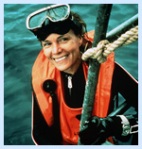The striped bass (Morone saxatilis) is the state fish of Maryland, Rhode Island, South Carolina, and the state saltwater fish of New York and New Hampshire. The fish is commonly referred to as the rockfish. The fish supports a $6.5 billion per year industry with 60,000 jobs as a recreational game species. Read more about this in the November 22, 2009 article in the Washington Times, “Anglers serve time for black-market rockfish trade” by Jim McElhatton.
Image (c) Fish and Wildlife Service via wikimedia
If you have any questions please e-mail beachchairscientist@gmail.com or let us know at http://www.beachchairscientist.com.


 u want short (often humorous) ocean science information? Follow the Beach Chair Scientist on twitter @bcsanswers. Often many job posting, fun pictures or just links to relevant information. Thanks.
u want short (often humorous) ocean science information? Follow the Beach Chair Scientist on twitter @bcsanswers. Often many job posting, fun pictures or just links to relevant information. Thanks. I was watching the October 13, 2009 episode of the Colbert Report on Comedy Central and was pleasantly surprised to when Stephen interviewed Sylvia Earle. Ms. Earle is a very accomplished ocean explorer.
I was watching the October 13, 2009 episode of the Colbert Report on Comedy Central and was pleasantly surprised to when Stephen interviewed Sylvia Earle. Ms. Earle is a very accomplished ocean explorer.

 and not as intimidating as people once thought.
and not as intimidating as people once thought.







What people are saying …